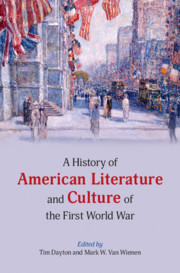Book contents
- A History of American Literature and Culture of the First World War
- A History of American Literature and Culture of the First World War
- Copyright page
- Contents
- Figures
- Contributors
- Acknowledgments
- Introduction America’s Great War at One Hundred (and Counting)
- Part I Genre and Medium
- Part II Settings and Subjects
- Part III Transformations
- Chapter 22 The Nation
- Chapter 23 Free Speech
- Chapter 24 Labor
- Chapter 25 The Veteran
- Chapter 26 The Military-Industrial Complex
- Chapter 27 The World
- References
- Index
Chapter 26 - The Military-Industrial Complex
Practices, Precedents, and Literary Engagements
from Part III - Transformations
Published online by Cambridge University Press: 23 January 2021
- A History of American Literature and Culture of the First World War
- A History of American Literature and Culture of the First World War
- Copyright page
- Contents
- Figures
- Contributors
- Acknowledgments
- Introduction America’s Great War at One Hundred (and Counting)
- Part I Genre and Medium
- Part II Settings and Subjects
- Part III Transformations
- Chapter 22 The Nation
- Chapter 23 Free Speech
- Chapter 24 Labor
- Chapter 25 The Veteran
- Chapter 26 The Military-Industrial Complex
- Chapter 27 The World
- References
- Index
Summary
This essay traces the Cold War Military Industrial Complex (MIC) back to the period of American neutrality in WWI, when US armaments manufacturers grew exponentially through sales to the Allied Powers. Already during this period, the sizeable peace movement argued that US defense and foreign policy was beholden to armament corporations, and later critiqued the corporate profiteering and weak regulation in the procurement system the US developed to industrially mobilize for war. This essay examines two leftist texts making such arguments—Upton Sinclair’s Jimmie Higgins (1919), and John Dos Passos’ The Big Money (1936). Sinclair’s novel used a munitions-worker protagonist to examine the development of “total war,” which fragmented global labor solidarity by militarizing all industrial capacity; but its Bildungsroman form struggled to capture the expansiveness of the MIC. In contrast, Dos Passos leveraged modernist form to better chart the MIC’s interwar development, especially in the aircraft industry. The Big Money examines the MIC’s propensity to agentless violence and its hostility to workers’ movements, but also treats it as a potential space for class mobility and the bootstrap narrative—a hospitability echoed in the biography of Eddie Rickenbacker, the US’s most famous WWI flying ace and an aviation corporate titan.
Keywords
- Type
- Chapter
- Information
- Publisher: Cambridge University PressPrint publication year: 2021

